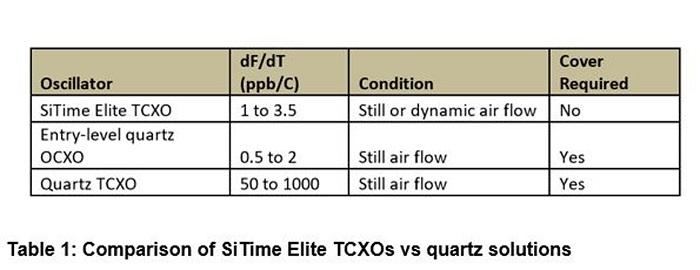By Gina Roos, editor-in-chief
SiTime’s Gary Giust, senior manager, product marketing, dispels some misconceptions about OCXO selection for established telecom and networking applications, as well as for emerging technologies like 5G networks, and discusses how thermal gradients impact the stability of a precision oscillator.

Gary Giust, senior manager, product marketing, SiTime
Electronic Products:Why is the stability-over-temperature specification misleading in some applications?
Gary Giust: Conventional wisdom might suggest that a designer selects an OCXO for a project based on its banner datasheet specification for frequency stability over temperature. However, this stability-over-temperature specification often serves as a proxy for overall stability. In certain applications, this can be misleading because it fails to capture the stability of an oscillator when placed in a dynamically changing environment.
EP:What specs should designers take a closer look at when working on designs that are sensitive to thermal gradients?
Giust: The frequency-versus-temperature slope of a precision oscillator, also known as dF/dT, is a critical consideration for designs that are sensitive to thermal gradients. For example, the electronics in 5G radios are subject to a wide variety of dynamic thermal conditions but rely on convection cooling. In practice, significant temperature gradients inside the radio enclosure can occur for many reasons, including sudden rain showers, cold fronts, wind gusts, and heat bursts from thunderstorms collapsing, any of which can change the ambient temperature tens of degrees or more in minutes. It is important to note that temperature changes can also result from internal changes; for example, processing a burst of data can increase the ambient temperature by several degrees and impact a nearby oscillator.
In such applications, MEMS-based TCXOs can provide higher stability than quartz devices. For example, the dF/dT performance of SiTime’s MEMS-based Elite Super-TCXOs is largely independent of whether the airflow across the device is still or breezy. In comparison, quartz TCXOs perform better in still air (not real-world use cases) and can significantly degrade when subjected to breezy conditions.
The Elite SiT5356 MEMS Super-TCXOs’ dF/dT performance remains fairly constant across the full operating temperature range. It is also the case that the Elite TCXOs’ dF/dT performance is maintained for large temperature-ramp rates, e.g., 5°C/min, whereas they degrade for quartz devices. This level of TCXO dF/dT performance is comparable to that of entry-level OCXOs (Table 1 ).

EP:How does dF/dT performance translate into better performance for 5G networks?
Giust: dF/dT performance is an important factor for providing time synchronization in IEEE 1588 networks, where lower dF/dT translates to more accurate time stamps. 5G networks and other high-reliability applications, such as financial trading systems and smart power grids, rely on the stability of the oscillator to provide accurate time stamps that enable real-time services.
Real-time 5G applications rely on IEEE 1588 to enable time synchronization over packet networks with minimal packet delay variation (PDV). This is desirable because PDV adds noise to time values and degrades the user experience of real-time services. Selecting an oscillator having a lower dF/dT allows the designer to decrease the IEEE 1588 servo-loop bandwidth, which filters more PDV and provides a more accurate time stamp for real-time services to promote.
EP: What about the cost associated with high-stability performance?
Giust: This level of stability can also provide a cost saving within the overall design. The Elite MEMS TCXOs are lower-cost than entry-level OCXOs. The integrated devices also occupy significantly less area than OCXOs, which can be critical for space-constrained designs. Elite TCXOs also integrate voltage regulation, eliminating the need for external regulators.
In addition to saving board space, Elite TCXOs also offer flexibility. Unlike OCXOs, which have to be isolated, Elite TCXOs can be placed anywhere on the board without restriction. For example, they can be placed next to fans cycling on/off or next to large, current-hungry ASICs and do not need to be covered with a metal or plastic lid, keeping the overall height to a minimum.
There are also operational advantages compared with entry-level OCXOs. Elite MEMS Super-TCXOs operate at temperatures up to 105°C and support frequencies up to 220 MHz, compared with a typical OCXO, which operates up to 85°C and 50 MHz.
Elite MEMS Super-TCXOs are also more reliable. These high-quality TCXOs have a 100% silicon supply chain, enabled by a silicon-based [MEMS] resonator. In addition, they are not susceptible to timing anomalies characteristic of quartz devices, including frequency jumps and activity dips.

The performance of the Elite SiT5356 MEMS Super-TCXOs is enabled by SiTime’s proprietary DualMEMS technology and TurboCompensation temperature-sensing scheme. The TCXOs also leverage SiTime’s unique architecture of two silicon MEMS resonators co-fabricated in a single die (DualMEMS technology) and a mixed-signal CMOS IC with TurboCompensation technology. This results in exceptional frequency stability over temperature and robustness to dynamic thermal disturbances.(This is illustrated in a short video.)
EP: If thermal gradients have such a big impact on the stability of a precision oscillator, do you find that designers are taking a closer look at dF/dT performance?
Giust: These considerations should be borne in mind by any designer of systems impacted by thermal gradients, such as telecom and networking equipment. For superior performance, the selection of precision oscillators should account for the dF/dT performance instead of simply the traditional stability-over-temperature specification.
Advertisement
Learn more about Electronic Products Magazine





